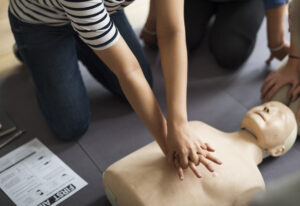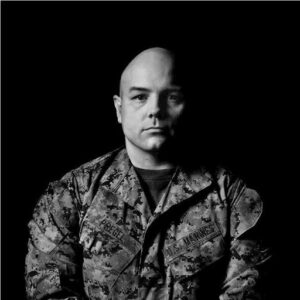In an emergency, seconds matter. Whether it’s a cardiac arrest at a workplace, school, or public setting, having the knowledge and skills to respond effectively can mean the difference between life and death. Cardiopulmonary Resuscitation (CPR) and Automated External Defibrillator (AED) training equip individuals with the ability to take immediate action in critical situations. At ProActive Response Group, we emphasize the significance of CPR and AED training not just as a skill but as a responsibility.
Every year, over 350,000 out-of-hospital cardiac arrests occur in the United States, and unfortunately, the survival rate remains low. Immediate intervention with CPR and an AED can double or even triple a victim’s chance of survival. The critical minutes before emergency responders arrive are often the most crucial, and having trained bystanders can bridge the gap and save lives.

CPR is a life-saving technique that keeps oxygenated blood flowing to the brain and other vital organs until medical professionals can take over. When the heart stops beating effectively, blood circulation ceases, and within minutes, permanent brain damage or death can occur. By performing high-quality chest compressions and rescue breaths (if trained to do so), a responder can maintain the flow of oxygen to the body, buying crucial time.
Key benefits of CPR:
An AED is a portable medical device that delivers an electric shock to a heart experiencing sudden cardiac arrest (SCA). The shock can restore a normal rhythm, potentially saving a life. AEDs are designed to be user-friendly, with visual and auditory instructions that guide individuals through the process step by step.
Why AEDs are essential:
The American Heart Association (AHA) outlines a “Chain of Survival” that highlights the necessary steps for increasing survival rates in cardiac emergencies:
Each link in the chain is crucial, and CPR and AED training empowers everyday individuals to take action during the first three steps, dramatically improving survival odds.
CPR and AED training are not just for healthcare professionals. These life-saving skills should be a priority for individuals in various sectors, including:
Despite the proven benefits of CPR and AED use, misconceptions prevent many from getting trained or stepping in to help. Here are some common myths debunked:
While bystander intervention is valuable, formal training provides the confidence and skills needed to respond effectively. CPR and AED certification courses cover:
At ProActive Response Group, we offer hands-on training tailored to individuals, workplaces, and organizations, ensuring participants feel prepared to act in real-world emergencies.
Saving lives begins with education and preparedness. Here’s how you can make a difference:
CPR and AED training is not just a skill—it’s a responsibility that can save lives. When sudden cardiac arrest strikes, every second counts. By equipping individuals with the knowledge and confidence to respond effectively, we can increase survival rates and make our communities safer.
At ProActive Response Group, we are committed to empowering individuals with life-saving training. Whether you are an employer, educator, or community member, investing in CPR and AED education is an invaluable step toward preparedness and resilience. Sign up for a course today and be the difference in someone’s survival story.
Jim served as a Sheriff’s Deputy in Illinois for 30 years. During his time as a Deputy, Jim served on the SWAT team as an operator, team leader and Commander. Jim was involved in several barricaded gunman/hostage incidents as well as service of high risk arrest and search warrants.
Jim was a member of the US Marshals Great Lakes Regional Fugitive Task Force where he performed surveillance and fugitive apprehension. His team was responsible for thousands of high risk felony fugitive arrests. Jim also served in the patrol division where he earned the rank of Sergeant and was responsible for patrol operations. Jim received numerous awards throughout his career to include Deputy of the Year, medal of valor and unit citation for SWAT operations.
Jim was a state certified CQB (Close Quarter Battle) SWAT instructor as well as an Active Shooter Response instructor, providing training for multiple law enforcement agencies throughout the state of Illinois.

I’m a proven leader with a diverse background in defense, law enforcement, and emergency response. My career began as a Scout Sniper in the U.S. Marine Corps, where I earned the Navy and Marine Corps Commendation Medal. I then served as a security contractor in Afghanistan and Iraq, further developing my tactical and crisis management skills.
Domestically, I served as a Deputy for the Greenville County Sheriff’s Office, earning a Medal of Valor, and as a firefighter, where I was awarded a Life Saving Ribbon. These roles reflect my commitment to safety and service, demonstrating leadership under pressure and a passion for protecting others.
As part of the Proactive Response Group Team, I design and deliver comprehensive medical training, developing lesson plans and conducting hands-on sessions. I ensure that participants are equipped with essential medical skills, fostering a culture of continuous improvement and readiness. My role is vital in preparing our team to handle medical emergencies confidently and competently.
Email: jpregel16@gmail.com
Phone: 720-382-3184
LinkedIn: https://www.linkedin.com/in/james-pregel-67765451/
Chris is a retired Major from the Greenville County Sheriff’s Office in South Carolina. Chris was third in command over operations, overseeing more than 300 sworn Deputies as well as all special teams within the Sheriff’s Office. In 2012, Chris helped to organize a Dignitary Protection Team within the Sheriff’s Office that assisted the Secret Service with Presidential and Vice Presidential visits throughout the state. In addition to his normal duties, Chris performs private security for dignitaries, celebrities, as well as 12 years with the Miss America Organization. Chris has been instructing Active shooter Response with ProActive Response Group since 2021.
In his down time, Chris enjoys time with his wife and daughter, as well as watching sports and fishing.
Email: ctaylor@proactiverg.com
Phone: 864-979-0978
LinkedIn: https://www.linkedin.com/in/chris-taylor-331b00150/
Tyrie Fowler is an Active Shooter Response instructor at Proactive Response Group and an Emergency Medicine Trauma Nurse at Prisma Health in Greenville. A Greenville native, Tyrie earned his Exercise Science degree from the University of South Carolina and his nursing degree from Mary Black School of Nursing. He joined Greenville Health System in 2015, transitioning from Orthopedic Trauma to Emergency Medicine. At Prisma Health, a Level One Trauma Center, he is part of the Trauma Nurse Leader team, with training in Advanced Trauma Care (ATCN) and Tactical Emergency Casualty Care (TECC). Tyrie is pursuing certifications in Emergency Nursing (CEN) and Trauma Certified Registered Nurse (TCRN).
Tyrie enjoys Fall for its long runs, college football (Go Gamecocks!), and hunting, including deer and quail. He also loves smoking recipes with a creative twist. As a medical instructor, Tyrie empowers bystanders to provide critical assistance in emergencies, teaching them to control bleeding and manage injuries, ensuring they leave his class confident in making a difference.
Steven J. Anderson is currently an Active Shooter Response Instructor for ProActive Response Group; he enjoys empowering people to survive in life threatening situations. Steve grew up in central Minnesota and spent three years with the United States Army. He graduated from St. Cloud State University with a degree in Criminal Justice. Steve worked as a federal agent for the United States Border Patrol where he was a member of the U.S. Border Patrol Tactical Unit (BORTAC): completing multiple assignments in Central & South America, an assignment with the United Nations and the Deputy Director (A) of the National Air Security Operation Center. In 2020 he retired from working in Federal Law Enforcement.
In his spare time he enjoys the outdoors especially bow hunting. Steve is a proud husband and father to 3 wonderful daughters.
Rob is originally from Louisville, CO. He joined the U.S. Marine Corps in 2003 and served as a Combat Engineer Officer until 2012. Rob deployed in support of Operation Enduring Freedom in 2009 and 2010 where he planned and implemented force protection strategy, counter improvised explosive device operations, and mobility operations for Third Battalion Sixth Marine Regiment and Third Battalion Seventh Marine Regiment . Upon his departure from the military, Rob began to teach firearms and tactics with Arizona based Alpine Arms while simultaneously running his own small residential security consulting firm. Rob relocated the South Carolina in 2021 and joined ProActive Response Group in early 2023.
When not working Rob spends time with his wife Lindsey and son Theo. He enjoys stand up paddle boarding, visiting the rifle range, four wheeling, and camping.
Phone: 720-382-3184
LinkedIn: https://www.linkedin.com/in/robert-christian-29579649/
Andy Sexton spent 12 years with the Greenville County Sheriff’s office in South Carolina, where he held the rank of Uniform Patrol Sergeant. His experience includes serving as an assistant SWAT team leader, involvement in high-risk incidents, including hostage rescues and the protection of dignitaries, working in criminal investigations (including armed robbery and homicide), and serving on the training committee for the Greenville County Sheriff’s Office.